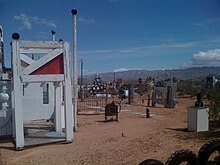Noah Purifoy
| Noah Purifoy | |
|---|---|

Noah Purifoy Outdoor Art Museum in Joshua Tree, California
|
|
| Born |
Noah Purifoy August 17, 1917 Snow Hill, Alabama |
| Died | March 5, 2004 Joshua Tree, California |
| Nationality | American |
| Education | Chouinard Art Institute |
| Known for | Assemblage Sculpture |
| Website | noahpurifoy |
Noah S. Purifoy (1917–2004) was an African American visual artist and sculptor, co-founder of the Watts Towers Art Center, and creator of the Noah Purifoy Outdoor Desert Art Museum. He lived and worked most of his life in Los Angeles and Joshua Tree, California.
He is best known for his assemblage sculpture, including a body of work made from charred debris and wreckage collected after the Watts Riots of August 1965.
Purifoy was born in Snow Hill, Alabama in 1917. During World War II, he served with the United States Navy, and as a veteran he was buried at the Ohio Western Reserve National Cemetery in Rittman, Ohio.
In 1953, he moved to Los Angeles to attend Chouinard Art Institute (now CalArts). Purifoy was the first African American to enroll there as a full-time student and earned his BFA in 1956, just before his fortieth birthday.
In the months after the Watts Riots rebellion of August 1965, Purifoy and artist Judson Powell organized the exhibition 66 Signs of Neon, composed of roughly 50 works of art made from salvaged materials as a way to "interpret the August event." The exhibition premiered at Markham Junior High School (April 3–9, 1966) with work by six artists and later traveled to nine state universities in California, eventually traveling to other venues throughout the United States. For twenty years following the rebellion, Purifoy dedicated himself to the found object, and to using art as a tool for social change.
He was cofounder of the Watts Towers Art Center, adjacent to Simon Rodia's landmark Watts Towers in Watts, Los Angeles, California.
Purifoy was on the California Arts Council from the late 1970s through late 1980s, initiating programs such as Artists in Social Institutions, bringing art into the state prison system. He then moved to the southern Mojave Desert to create artworks.
...
Wikipedia
